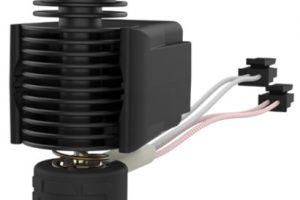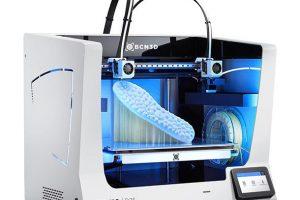
Like ‘MLSA’ resin vat printing, the technology is fundamentally ultra-violet-cured polymer, cured by LCD shutter patterning in this case. As such, it prints a whole bed of objects just as quickly as it prints one – unlike ‘FDM’ or ‘FFF filamant extrusion printing.
Unlike MLSA printing, the BCN3D process can build objects from highly viscous resins: “50x more viscous than the industry standard”, it claims, allowing chemists to formulate materials that print into tougher end-products – for example by incorporating long chain oligomers or fillers such as fibres (even abrasive fibres) or elastomer particles.
“Without a strict low viscosity constraint, chemical companies obtain the freedom to formulate as a whole new set of ingredients and modifiers can be added in the resin to achieve the desired effect on thermal and mechanical properties,” according to BCN3D. “VLM processes resins that obtain 3x the amount of impact resistance for rigid materials and a 200% increment in tear strength compared to industry-standard formulations.”
VLM is the brand of the new process, an abbreviation of viscous lithography manufacturing. It has taken three years to develop.
How does it work?
A VLM printer (left) has a horizontal print bed underneath a horizontal transparent plastic film that is coated on its underside with a calibrated thickness of uncured liquid resin (pink in the diagram).
The bed moves up to just touch the resin film, at which point the LCD, mounted just above the film, beams the necessary layer image through the film, hardening the necessary resin pattern onto the bed.
For the next layer, the bed moves away slightly downwards and the film slides away sideways taking residual resin with it to a unit which recycles it so “every drop of resin eventually becomes a printed part” said BCN3D.
The film is actually double the width of the bed and, as the used part slides away to one side, it drags a newly-resin-coated length of film in from the other side. Once the film stops, it is ready for the bed to move up to print the next layer. The film shuttles back and forth for subsequent layers.
As there is a complete wiper-depositor at each side, two different resins can be supplied, one from each side, making dual material prints possible – to add soluble supports, for example, or the same material can be supplied from each side to double print speed.
As is usual with resin prints, the parts need further UV exposure after printing to develop full strength.
Materials company Arkema has been developing suitable photocurable resins with BCN3D.

“We are focusing on monocomponent formulations, since high viscosities enable high performance while avoids the drawbacks and limitations of bicomponent approaches. VLM is not constrained to acrylic formulations,” BCN3D CTO Eric Pallarés told Electronics Weekly.
As they are mono-component, and can be used at room temperature, in-machine-life is extended compared with multi-component resins, particularly compared with those that need to be heated to make them flow.
How strong will the finished polymers be?
“The portfolio of available materials is being defined together with Arkema,” said allarés. “We expect the VLM Technology Adoption Program to help us detect market needs to fine-tune an initial resin portfolio, spanning from high-temperature to elastomeric applications.”
The adoption programme has already been set up, and is aimed at businesses of all shapes and sizes, said the company, which has also created a releated applications centre.
In a video it released as it announced VLM, one slide indicated tensile strength >6MPa and nearly 120% elongation at break (so 220% of initial length) for example resins.
How thick can the resin be?
“VLM can effectively handle viscosities around 100Pa·s at room temperature,” said Pallarés. However, a limitation is that the resin cannot be too runny as it needs to hang from the film briefly.
As well as a chemical company, BCN3D has partnered a couple of 3D print users.
Motor-sports company Prodrive has been assembling parts made using VLM onto cross-country vehicles.
“VLM allows us to continue to use the engineering materials that we know and love, but instead in significantly finer resolution in all three directions, and the material is much more homogeneous, making the finished parts behave much more like a traditional injection moulded part,” said Prodrive engineer Callum Harper.
Glass maker Saint Gobain is the other. For which “7,000 positioning fixtures have been fabricated in seven days with VLM for 0.79€ per part”, according to BCN3D.
What sort of company is this technology aimed at?
“VLM-based solutions”, said BCN3D, will be under €50,000. “By implementing the use of VLM, the cost per part is significantly lower than those of powder-based and resin-based technologies,” it said. “Unlocking manufacturing autonomy using 3D printing should be for every single business that develops and manufactures concepts or products, in any industry.”
Here is the VLM video, and BCN3D will be showing VLM at Rapid (17-19th of May, Detroit).